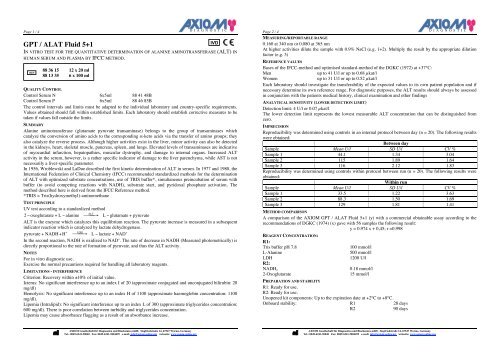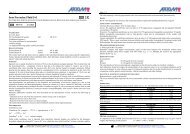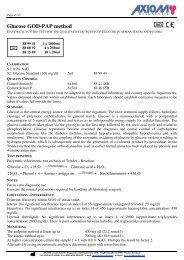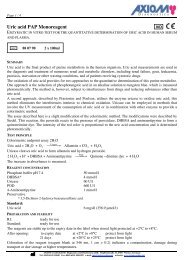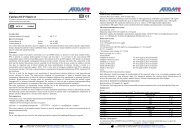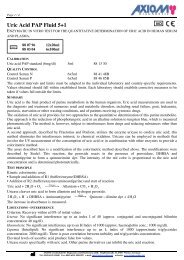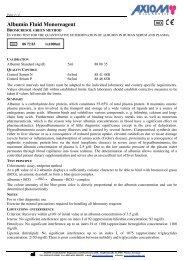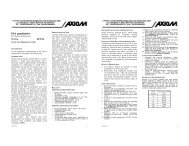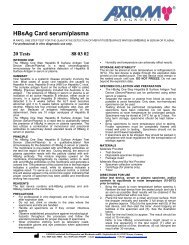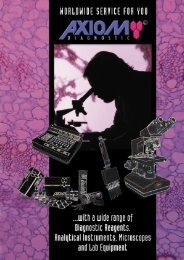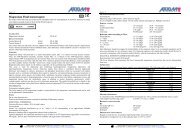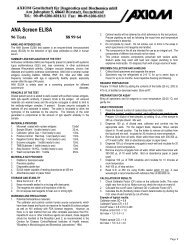GPT ALAT 88 36 15 - AXIOM Solutions
GPT ALAT 88 36 15 - AXIOM Solutions
GPT ALAT 88 36 15 - AXIOM Solutions
Create successful ePaper yourself
Turn your PDF publications into a flip-book with our unique Google optimized e-Paper software.
!<br />
!<br />
Page 1 / 4<br />
<strong>GPT</strong> / <strong>ALAT</strong> Fluid 5+1<br />
<strong>88</strong> <strong>36</strong> <strong>15</strong> 12 x 20 ml<br />
<strong>88</strong> 13 35 6 x 100 ml<br />
D I A G N O S T I C<br />
IN VITRO TEST FOR THE QUANTITATIVE DETERMINATION OF ALANINE AMINOTRANSFERASE (ALT) IN<br />
HUMAN SERUM AND PLASMA BY IFCC METHOD.<br />
REF<br />
RE<br />
F<br />
QUALITY CONTROL<br />
Control Serum N 6x5ml <strong>88</strong> 41 48B<br />
Control Serum P 6x5ml <strong>88</strong> 46 85B<br />
The control intervals and limits must be adapted to the individual laboratory and country-specific requirements.<br />
Values obtained should fall within established limits. Each laboratory should establish corrective measures to be<br />
taken if values fall outside the limits.<br />
SUMMARY<br />
Alanine aminotransferase (glutamate pyruvate transaminase) belongs to the group of transaminases which<br />
catalyze the conversion of amino acids to the corresponding !-keto acids via the transfer of amino groups; they<br />
also catalyze the reverse process. Although higher activities exist in the liver, minor activity can also be detected<br />
in the kidneys, heart, skeletal muscle, pancreas, spleen, and lungs. Elevated levels of transaminases are indicative<br />
of myocardial infarction, hepatopathies, muscular dystrophy, and damage to internal organs. Increased ALT<br />
activity in the serum, however, is a rather specific indicator of damage to the liver parenchyma, while AST is not<br />
necessarily a liver-specific parameter.<br />
In 1956, Wroblewski and LaDue described the first kinetic determination of ALT in serum. In 1977 and 1980, the<br />
International Federation of Clinical Chemistry (IFCC) recommended standardized methods for the determination<br />
of ALT with optimized substrate concentrations, use of TRIS buffer*, simultaneous preincubation of serum with<br />
buffer (to avoid competing reactions with NADH), substrate start, and pyridoxal phosphate activation. The<br />
method described here is derived from the IFCC Reference method.<br />
*TRIS = Tris(hydroxymethyl)-aminomethane<br />
TEST PRINCIPLE<br />
UV test according to a standardized method<br />
ALT<br />
2 " oxoglutarate + L " alanine # # $ L " glutamate + pyruvate<br />
ALT is the enzyme which catalyzes this equilibrium reaction. The pyruvate increase is measured in a subsequent<br />
indicator reaction which is catalyzed by lactate dehydrogenase.<br />
pyruvate + NADH+H + " LDH "#<br />
L $ lactate + NAD +<br />
In the second reaction, NADH is oxidized to NAD + . The rate of decrease in NADH (Measured photometrically) is<br />
directly proportional to the rate of formation of pyruvate, and thus the ALT activity.<br />
NOTES<br />
For in vitro diagnostic use.<br />
Exercise the normal precautions required for handling all laboratory reagents.<br />
LIMITATIONS - INTERFERENCE<br />
Criterion: Recovery within ±10% of initial value.<br />
Icterus: No significant interference up to an index I of 20 (approximate conjugated and unconjugated bilirubin: 20<br />
mg/dl)<br />
Hemolysis: No significant interference up to an index H of 1100 (approximate haemoglobin concentration: 1100<br />
mg/dl).<br />
Lipemia (Intralipid): No significant interference up to an index L of 300 (approximate triglycerides concentration:<br />
600 mg/dl). There is poor correlation between turbidity and triglycerides concentration.<br />
Lipemia may cause absorbance flagging as a result of an absorbance increase.<br />
IVD<br />
Page 2 / 4<br />
D I A G N O S T I C<br />
MEASURING/REPORTABLE RANGE<br />
0.160 at 340 nm or 0.080 at <strong>36</strong>5 nm<br />
At higher activities dilute the sample with 0.9% NaCl (e.g. 1+2). Multiply the result by the appropriate dilution<br />
factor (e.g. 3)<br />
REFERENCE VALUES<br />
Bases of the IFCC-method and optimised standard-method of the DGKC (1972) at +37°C:<br />
Men<br />
up to 41 U/l or up to 0.68 µkat/l<br />
Women<br />
up to 31 U/l or up to 0.52 µkat/l<br />
Each laboratory should investigate the transferability of the expected values to its own patient population and if<br />
necessary determine its own reference range. For diagnostic purposes, the ALT results should always be assessed<br />
in conjunction with the patients medical history, clinical examination and other findings<br />
ANALYTICAL SENSITIVITY (LOWER DETECTION LIMIT)<br />
Detection limit: 4 U/l or 0.07 µkat/l<br />
The lower detection limit represents the lowest measurable ALT concentration that can be distinguished from<br />
zero.<br />
IMPRECISION<br />
Reproducibility was determined using controls in an internal protocol between day (n = 20). The following results<br />
were obtained:<br />
Between day<br />
Sample Mean U/l SD U/l CV %<br />
Sample 1 44.1 1.34 3.04<br />
Sample 2 1<strong>15</strong> 1.89 1.64<br />
Sample 3 116 2.12 1.83<br />
Reproducibility was determined using controls within protocol between run (n = 20). The following results were<br />
obtained:<br />
Within run<br />
Sample Mean U/l SD U/l CV %<br />
Sample 1 33.5 1.22 3.63<br />
Sample 2 <strong>88</strong>.3 1.50 1.69<br />
Sample 3 129 1.81 1.41<br />
METHOD COMPARISON<br />
A comparison of the <strong>AXIOM</strong> <strong>GPT</strong> / <strong>ALAT</strong> Fluid 5+1 (y) with a commercial obtainable assay according to the<br />
recommendations of DGKC (1974) (x) gave with 56 samples the following result:<br />
y = 0.974 x + 0,45; r =0.998<br />
REAGENT CONCENTRATION:<br />
R1:<br />
Tris buffer pH 7.8<br />
L-Alanine<br />
LDH<br />
R2:<br />
NADH 2<br />
2-Oxoglutarate<br />
100 mmol/l<br />
500 mmol/l<br />
1200 U/l<br />
0.18 mmol/l<br />
<strong>15</strong> mmol/l<br />
PREPARATION AND STABILITY<br />
R1: Ready for use.<br />
R2: Ready for use.<br />
Unopened kit components: Up to the expiration date at +2°C to +8°C.<br />
Onboard stability: R1 28 days<br />
R2<br />
90 days<br />
<strong>AXIOM</strong> Gesellschaft für Diagnostica und Biochemica mbH; Siegfriedstraße 14, 67547 Worms, Germany<br />
Tel.: 0049-6241-50040 Fax: 0049-6241-5004499 e-mail: info@axiom-online.net webseite: www.axiom-online.net<br />
<strong>AXIOM</strong> Gesellschaft für Diagnostica und Biochemica mbH; Siegfriedstraße 14, 67547 Worms, Germany<br />
Tel.: 0049-6241-50040 Fax: 0049-6241-5004499 e-mail: info@axiom-online.net webseite: www.axiom-online.net
Page 3 / 4<br />
D I A G N O S T I C<br />
SPECIMEN<br />
Collect serum using standard sampling tubes.<br />
Heparin or EDTA plasma.<br />
Stability: 24 hours at +20°C to +25°C<br />
3 days at +2°C to +8°C<br />
Separate serum/plasma from clot/cells within 8 hours at room temperature or 48 hours at +2°C to +8°C.<br />
Centrifuge samples containing precipitate before performing the assay<br />
TESTING PROCEDURE<br />
Materials provided<br />
• Working solutions as described above<br />
Additional materials required<br />
• Controls as indicated below<br />
• 0.9% NaCl<br />
Manual procedure serum start:<br />
Wavelength<br />
Hg 334 nm, 340 nm or Hg <strong>36</strong>5 nm<br />
Temperature<br />
+25°C / +30°C / +37°C<br />
Cuvette<br />
1cm light path<br />
Zero adjustment<br />
against air<br />
Mix R1 and R2 5+1. This solution is stable: up to 10 days at +2°C to +8°C or<br />
up to 1 day at +20°C to +25°C<br />
Reagent mixture 1000 µl<br />
Serum / plasma 100 µl<br />
Mix and incubate 60 seconds at assay temperature and start stopwatch simultaneously. Read again after exactly<br />
1, 2 and 3 minutes.<br />
Calculation:<br />
Hg <strong>36</strong>5 nm<br />
Hg 340 nm<br />
Hg 334 nm<br />
3235 x !A/min<br />
1746 x !A/min<br />
1780 x !A/min<br />
Manual procedure substrat start:<br />
Wavelength<br />
Hg 334 nm, 340 nm or Hg <strong>36</strong>5 nm<br />
Temperature<br />
+25°C / +30°C / +37°C<br />
Cuvette<br />
1cm light path<br />
Zero adjustment<br />
against air<br />
R 1 1000 µl<br />
Serum / plasma 100 µl<br />
Mix and incubate 60 seconds at assay temperature then add<br />
R2 200 µl<br />
Mix, read initial absorbance and start stopwatch simultaneously. Repeat reading after exactly 1, 2 and 3 min.<br />
Calculation:<br />
Hg <strong>36</strong>5 nm<br />
Hg 340 nm<br />
Hg 334 nm<br />
CALIBRATION FREQUENCY<br />
Two point calibration is recommended<br />
• after reagent lot change<br />
• as required following quality control procedures<br />
Calibration verification: Not necessary<br />
3823 x !A/min<br />
2063 x !A/min<br />
2103 x !A/min<br />
Page 4 / 4<br />
DISPOSAL<br />
Please note the legal regulations.<br />
D I A G N O S T I C<br />
LITERATURE<br />
1. Bablok W et al. A General Regression Procedure for Method Transformation. J Clin Chem Clin Biochem 19<strong>88</strong>; 26:783-790.<br />
2. Berg Meyer HU, Herder M, Red R. Approved recommendation (1985) on IFCC methods for the measurement of catalytic<br />
concentration of enzymes. Part 3. (FCC Method for alanine aminotransferase. J Clin Chem Clin Biochem 1986; 24:481-489.<br />
3. Glick MR, Ryder KW, Jackson SA. Graphical Comparisons of Interferences in Clinical Chemistry Instrumentation.<br />
Clin Chem 1986;32:470-474.<br />
4. Greiling H, Gressner AM (Hrsg.). Lehrbuch der Klinischen Chemie und Pathobiochemie, 3rd Stuttgart/New York:<br />
Schattauer Verlag, 1995.<br />
5. Passing H, Bablok W. A New Biometrical Procedure for Testing the Equality of Measurements from Two Different Analytical<br />
Methods. J Clin Chem Clin Biochem 1983;21 :709-720.<br />
6. Thefeld W et al. Dtsch med Wschr 1974;99:343.<br />
7. Tietz NW (Hrsg.). Clinical Guide to Laboratory Tests, 3rd Philadelphia, Pa: WB Saunders, 1995:20-21.<br />
8. Wallnöfer H, Schmidt E, Schmidt FW (Hrsg.). Synopsis der Leber- krankheiten. Stuttgart: Georg Thieme Verlag, 1974.<br />
9. Wroblewski F LaDue JS. Ann Intern Med 1956;45:801.<br />
10. Wroblewski F, LaDue JS. Proc Soc Exp Biol Med 1956;91 :569.<br />
<strong>AXIOM</strong> Product range Clinical Chemistry<br />
Enzymes Ions Other Metabolites<br />
Acid Phosphatase Ammonium fluid Bilirubin T/D<br />
Alkaline Phosphatase Copper fluid Creatinine fluid<br />
!-Amylase direct Calcium fluid Glucose GOD-PAP fluid<br />
CK-NAC actived Chloride fluid Glucose Hexokinase fluid<br />
CK-MB (NAC- actived) Inorganic Phosphorus UV fluid Urea Enzymatic fluid<br />
"-GT fluid Iron fluid Urea UV fluid<br />
LDH fluid TIBC Uric Acid PAP fluid<br />
Cholinesterase<br />
Magnesium fluid<br />
GOT/ASAT fluid<br />
Potassium fluid<br />
<strong>GPT</strong>/<strong>ALAT</strong> fluid<br />
Sodium fluid<br />
Controls<br />
Lipase UV fluid<br />
Control Serum N<br />
Lactate PAP<br />
Control Serum P<br />
Proteins<br />
!-HBDH<br />
Lipids<br />
Albumin<br />
CSF-Protein fluid<br />
Cholesterol fluid<br />
Microprotein fluid<br />
HDL Cholesterol<br />
Hemoglobin<br />
LDL Cholesterol<br />
Protein Total fluid<br />
Triglycerides fluid<br />
06/09 M/kd<br />
<strong>AXIOM</strong> Gesellschaft für Diagnostica und Biochemica mbH; Siegfriedstraße 14, 67547 Worms, Germany<br />
Tel.: 0049-6241-50040 Fax: 0049-6241-5004499 e-mail: info@axiom-online.net webseite: www.axiom-online.net<br />
<strong>AXIOM</strong> Gesellschaft für Diagnostica und Biochemica mbH; Siegfriedstraße 14, 67547 Worms, Germany<br />
Tel.: 0049-6241-50040 Fax: 0049-6241-5004499 e-mail: info@axiom-online.net webseite: www.axiom-online.net


